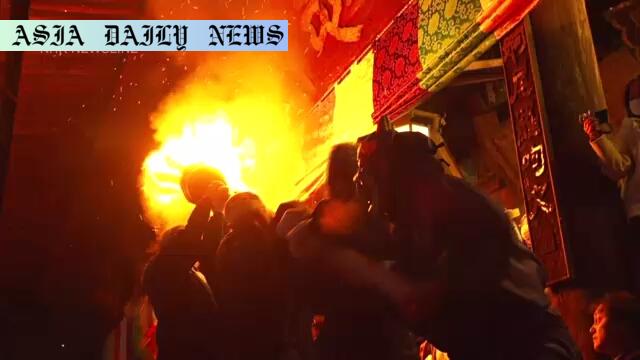Dadaoshi ritual concludes at the historic Hasedera Temple in Nara, featuring dramatic demon banishment and prayers for good health.
Dadaoshi is a Buddhist ritual marking the end of Shunie at Hasedera Temple in Nara.
Dramatic demon banishments and torch processions captivate visitors.
Amulets with special powers are used to repel demons and wish for health.
The unique tradition draws visitors from across Japan for its solemn yet powerful atmosphere.

The Significance of Dadaoshi Ritual
The Dadaoshi ritual at Hasedera Temple in Sakurai, Nara Prefecture, is one of the pivotal events in the region’s cultural calendar. Rooted in centuries-old Buddhist practices, this event marks the conclusion of the week-long Shunie service, which begins each year on February 8. It is both a spiritual and cultural spectacle, blending faith, tradition, and theatrics to create a once-in-a-lifetime experience for visitors.
The Setting: Hasedera Temple
The Hasedera Temple, with its designation as a national treasure, serves as the pristine location for this grand event. This temple is not only significant for its historical value but also holds a cherished place in the hearts of those who seek spiritual solace. During the Dadaoshi ritual, the temple’s main hall becomes the focal point of activities as it transforms into a stage for the dramatic entry of demons and monks engaging in prayers for health and prosperity.
A Dramatic Display of Faith
The special feature of Dadaoshi is its theatrical representation of demon banishment. Demons dressed in vibrant red, blue, and green outfits wield cudgels, entering to the powerful sounds of drums and conch shells. They circle the main hall in stunning formation, adding to the already electrifying atmosphere. Monks, armed with specially prepared amulets thought to possess spiritual powers, stand ready to repel these symbolic demons that represent evil and misfortune.
The Torch Procession
One of the most awe-inspiring moments of the ritual is the torch procession. Monks carry towering, four-meter-long burning torches weighing around 130 kilograms through the temple grounds. This act is not just a physical feat but also holds symbolic meaning. The burning torches represent the purification of space and the eradication of lingering negativity and misfortune. Visitors watch in awe, as the firelight dances through the temple’s historical architecture, creating a mesmerizing scene.
Visitor Impressions
The Dadaoshi ritual leaves a lasting impression on all who attend. Many visitors describe it as both solemn and powerful, with its combination of vibrant displays and deeply rooted spirituality. A couple from Nagoya who witnessed the ritual for the first time said they were moved by the experience and expressed their desire to return again. This sentiment is echoed by many others, illustrating the emotional and cultural bond strengthened during this event.
Preserving Tradition and Culture
Events like Dadaoshi are critical for preserving and passing down Japanese cultural heritage. They provide an opportunity for local communities to share their traditions with visitors from other parts of Japan and the world. This exchange of culture not only boosts interest in traditional Buddhist practices but also fosters a sense of unity and appreciation for the arts and spirituality.
Impact on Tourism
The vibrant display of rituals like Dadaoshi also benefits the local tourism industry. Nara Prefecture, known for its historical temples and cultural significance, draws significant crowds during these rituals. Visitors not only participate in the spiritual experiences but also explore other local attractions, contributing to the local economy. Events like these showcase the perfect blend of cultural preservation and modern tourism.
In conclusion, the Dadaoshi ritual at Hasedera Temple is much more than a religious event. It is a celebration of faith, culture, and community that leaves an indelible mark on all who experience it. It reflects the resilience and richness of Japanese traditions, keeping them alive for generations to come.
Commentary
A Tradition of Spiritual Significance
The Dadaoshi ritual is a fascinating glimpse into the spiritual and cultural tapestry of Japan. Such rituals do not merely symbolize religious sentiments; they encapsulate the resilience and enduring spirit of cultural heritage. As modern society progresses rapidly, rituals like these bridge the gap between the past and the present, reminding us of our shared history and values. The vivid imagery of demons, fire, and music evokes a sense of awe that transcends language and national boundaries.
A Moment of Reflection
Witnessing such a tradition also inspires personal reflection. The ritual serves as a metaphor for expelling negativity from one’s life and welcoming new beginnings with renewed hope. The sight of the torch procession, in particular, symbolizes purification and empowerment, qualities we all can connect with in our own lives. It reminds us how communal events foster not only spiritual growth but also a sense of unity among people.
The Role of Tourism and Cultural Exchange
Events like Dadaoshi are also a celebration of cultural exchange. They provide visitors—both domestic and international—with an enriching experience that blends spirituality, art, and community. Tourism driven by such events promotes mutual understanding and respect, making cultural preservation a global endeavor. It’s heartening to see how such traditions, despite their rootedness in history, find relevance and intrigue in a modern context.


